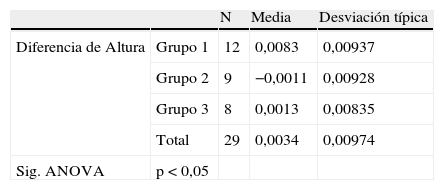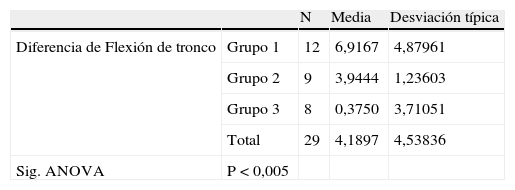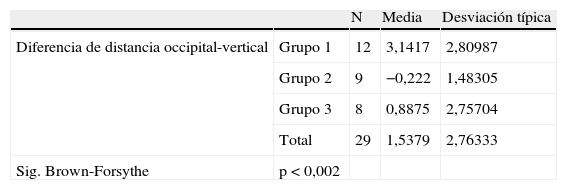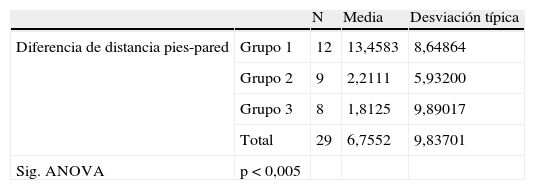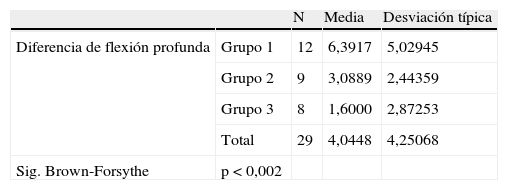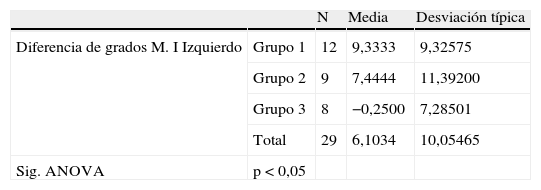Comprobar la efectividad del stretching global activo (SGA) en alumnos entre 16-17 años y compararlo con estiramientos analíticos.
Material y métodosEstudio prospectivo, aleatorio. Criterio de inclusión: 16-17 años y consentimiento informado por parte de los padres. Criterios de exclusión: patología y/o dolor, practicar deporte de manera reglada. 33 alumnos se asignaron aleatoriamente a los grupos 1 (SGA), 2 (estiramientos analíticos) y 3 (educación física). Se valoraron, antes y después de la intervención: altura, velocidad, salto vertical, salto horizontal, zancada, distancia del occipital/dorsal/sacro a la vertical, postura corporal y flexibilidad: general, de la musculatura dorso-lumbar (en relación con la cadena anterior de los miembros inferiores y superiores), de isquiotibiales y de la cadena posterior.
ResultadosLa prueba de chi al cuadrado de Pearson asocia al grupo SGA con mejoría en la sensación de mejora de flexibilidad y postura. Según el ANOVA y las pruebas post hoc de comparaciones múltiples, existe una mejora significativa del grupo SGA con respecto a los grupos 2 y/o 3 en: altura (p < 0,05), flexibilidad de la cadena posterior (p < 0,005), flexibilidad de isquiotibiales (miembro inferior izquierdo) (p < 0,05) y flexibilidad de la musculatura dorso-lumbar con respecto a la cadena anterior de miembros inferiores (p < 0,005). Según la prueba Brown-Forsythe y las post hoc, existe una mejora significativa del grupo SGA en: flexibilidad general (p<0,02) y distancia occipital-vertical (p<0,02). En las fotografías de diferentes posturas se aprecia en el grupo de SGA mejorías más significativas y en mayor número de fotografías.
ConclusionesEl SGA es efectivo e incluso más que los estiramientos analíticos en los aspectos mencionados. Tras los buenos resultados, sería interesante continuar investigando en otros ámbitos y edades.
To study the effectiveness of the global active stretching (SGA) in 16-17 year old students and to compare it to analytical stretching.
Material and methodsA prospective, randomized study was performed. Inclusion criteria: 16-17 years-old and informed consent from parents. Exclusion criteria: pathology and/or pain, practice regulated sport. A total of 33 students were randomly assigned to groups 1 (SGA), 2 (analytical stretching) and 3 (physical education). Some aspects were assessed before and after the research: height, speed, vertical jump, horizontal jump, stride, distance from occipital/back/sacrum to the vertical, posture and flexibility: general, of the dorsal-lumbar musculature (showing the relation between the anterior chain and the lower and upper limbs), the hamstrings and the posterior chain.
ResultsThe Pearson's chi-square test associated the SGA group with improved sense of improving flexibility and posture. According to the ANOVA and post-hoc tests of multiple comparisons, there was significant improvement in the SGA group compared to groups 2 and/or 3 in: height (P<.05), posterior chain flexibility (P<.005), left hamstring flexibility (P<.05) and flexibility of the dorsal-lumbar musculature in relation with the anterior chain of the lower limbs (P<.005). According to the Brown-Forsythe and the post-hoc, there is a significant improvement in SGA group in general flexibility (P<.02) and occipital-vertical distance (P <.02). It could be seen in the photographs obtained in different positions that the SGA group had the most significant improvements and in a greater number of photos.
ConclusionsSGA is effective and even more than the analytical stretching in the aspects mentioned above. Due to the good results, further investigation in other areas and ages would be interesting.
Artículo
Si ya tiene sus datos de acceso, clique aquí.
Si olvidó su clave de acceso puede recuperarla clicando aquí y seleccionando la opción "He olvidado mi contraseña".








